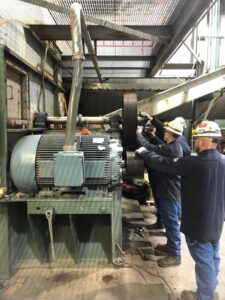Dynamic balancing is the process of running a piece of equipment at a given speed, measuring the dynamic imbalance, and correcting via the addition or removal of weight. This can be achieved by sending the rotating assembly out to a specialized shop or making the appropriate corrections on-site using field balancing techniques.


Correcting imbalance involves measuring the amplitude of the vibration signal produced by the imbalance and determining the phase (or location of the “heavy spot”) relative to a reference signal. Dynamic balancing is most often performed on industrial fans, hammer mills, and rotating equipment that is too large to remove and place in a conventional balance stand.
Excessive imbalance of rotating equipment can lead to serious mechanical failures and result in unexpected and costly downtime. For these reasons, detecting potential causes early on can be crucial for your operation. In this article, IBT’s Industrial Maintenance Technologies Group (IMT) shares some common factors that require dynamic balancing.
Common Factors that Require Dynamic Balancing


That’s why it’s important to keep certain factors in mind when it comes to performing dynamic balancing on your equipment. Here is a list of some of the most common instances for addressing imbalance:
- When there is significant material buildup present, operating conditions can cause wet or sticky matter to adhere to the surfaces of the rotating machinery and can cause significant imbalance. The best practice is to clean the rotor of all product/material buildup; however, this is often impractical or next to impossible.
- Any time there is a change in geometry or mass of the rotating assembly, (new blades, bars, rods, bearings, sheaves, etc.). Even small changes can lead to significantly increased imbalance at operating speed.
- If you are replacing a component, such as a bearing, and want to ensure that it won’t be put through unnecessary wear and extend the life of the product.
- If you are installing, removing, or replacing isolators. Isolators alter a machine’s dynamic response to mechanical forces.
Note: Acceptance testing should always be performed on brand-new rotating equipment. Every manufacturer of rotating equipment will attempt to address imbalance. Some are more effective than others, but even the best factory balance can be diminished after the installation is complete. Imbalance can be corrected on the spot and other faults can be identified as well.
Save Time and Money with IBT’s Industrial Maintenance Technologies Group (IMT)


In addition to dynamic balancing, we also provide vibration analysis, motion amplification, laser alignment, component installation and replacement services, and remote monitoring.
For more information about IBT’s Industrial Maintenance Services and how they can impact your business, call 816-877-4455 or request a quote today!





